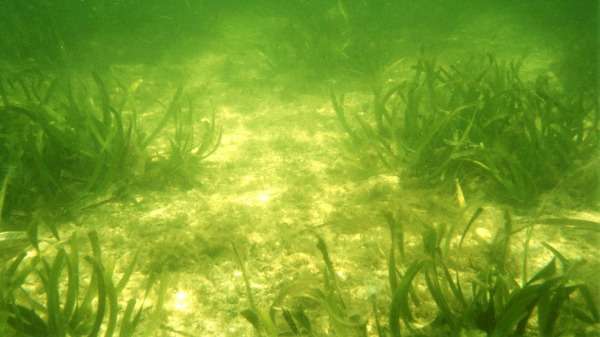A 1997 seagrass restoration trial, four years later in October 2001. Credit: Geoff Bastyan
When Geoff Bastyan noticed seagrass disappearing from harbours in Albany nearly 50 years ago, he would never have predicted his observation would lead to the most successful seagrass restoration in the world.
Mr Bastyan noticed a decline in the distribution and health of Posidonia australis and P. sinuosa seagrass, commonly known as ribbon weed, in Oyster and Princess Royal harbours in the late 1970s.
Seagrass is vital to healthy marine ecosystems – it provides food and habitat, improves water clarity and reduces coastal erosion by stabilising sediments, filters nutrients, oxygenates water and absorbs carbon dioxide.
Mr Bastyan was determined to document its disappearance, so he started self-funded monitoring programs of both harbours in 1981.
Back then, GPS technology was still being developed, so he spent countless hours scuba diving both harbours to record changes in seagrass species and density at different depths by hand, and also used aerial photography.
By 1988, Mr Bastyan's monitoring showed substantial seagrass losses of 80 per cent from Oyster Harbour and 90 per cent from Princess Royal Harbour.
Oyster Harbour was overloaded with agricultural nutrients from surrounding farmland, while Princess Royal Harbour had high levels of industrial waste and sewage.
Mr Bastyan's research prompted the Albany Harbours Environmental Study, a report to the Environmental Protection Authority, in 1988 and 1989.
The study found if agricultural and industrial pollutant loads continued, most of the remaining seagrass would be lost from Princess Royal Harbour within five years and Oyster Harbour within 10 years.
Mr Bastyan began seagrass transplant trials in 1994, in spite of the prevailing view that degraded seagrass meadows could not be rehabilitated.
His efforts to painstakingly relocate hundreds of plants across 2.6 hectares throughout the 1990s disproved this theory, with a 97 per cent survival rate making his work the most successful seagrass restoration project in the world.
Mr Bastyan has received international recognition as a seagrass restoration pioneer and accolades for his contribution to the understanding of seagrass ecology.
Last month, he was awarded the Great Southern Development Commission medal, which celebrates natural resource management best practice and includes a $12,000 grant.
The humble 58-year-old says he felt honoured and doesn't expect awards for doing what he loves.
"It's very humbling," he says.
"We do what we do for the love of the environment.
"It's stimulating to try and understand the natural processes in the ocean – it's a great office."
Mr Bastyan plans to use the grant to finish documenting the seagrass' natural regrowth and restorative effects on the harbours.
Provided by Science Network WA
This article first appeared on ScienceNetwork Western Australia a science news website based at Scitech.























